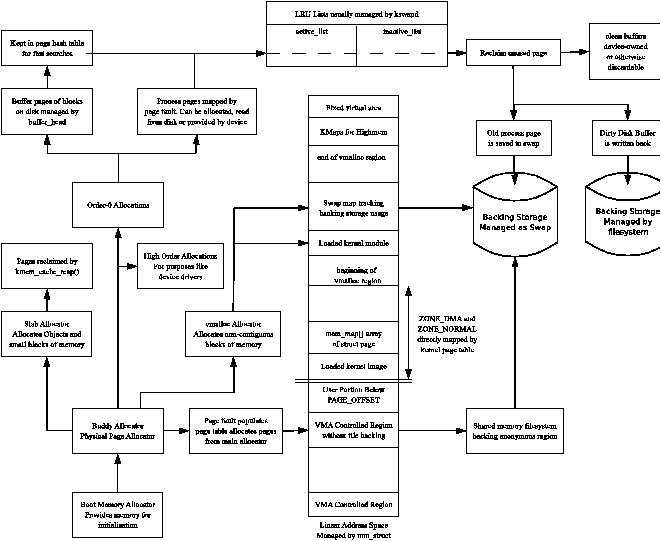
| Figure 14.1: Broad Overview on how VM Sub-Systems Interact |



Make no mistake, memory management is a large, complex and time consuming field to research and difficult to apply to practical implementations. As it is very difficult to model how systems behave in real multi-programmed systems [CD80], developers often rely on intuition to guide them and examination of virtual memory algorithms depends on simulations of specific workloads. Simulations are necessary as modeling how scheduling, paging behaviour and multiple processes interact presents a considerable challenge. Page replacement policies, a field that has been the focus of considerable amounts of research, is a good example as it is only ever shown to work well for specified workloads. The problem of adjusting algorithms and policies to different workloads is addressed by having administrators tune systems as much as by research and algorithms.
The Linux kernel is also large, complex and fully understood by a relatively small core group of people. It's development is the result of contributions of thousands of programmers with a varying range of specialties, backgrounds and spare time. The first implementations are developed based on the all-important foundation that theory provides. Contributors built upon this framework with changes based on real world observations.
It has been asserted on the Linux Memory Management mailing list that the VM is poorly documented and difficult to pick up as “the implementation is a nightmare to follow”1 and the lack of documentation on practical VMs is not just confined to Linux. Matt Dillon, one of the principal developers of the FreeBSD VM2 and considered a “VM Guru” stated in an interview3 that documentation can be “hard to come by”. One of the principal difficulties with deciphering the implementation is the fact the developer must have a background in memory management theory to see why implementation decisions were made as a pure understanding of the code is insufficient for any purpose other than micro-optimisations.
This book attempted to bridge the gap between memory management theory and the practical implementation in Linux and tie both fields together in a single place. It tried to describe what life is like in Linux as a memory manager in a manner that was relatively independent of hardware architecture considerations. I hope after reading this, and progressing onto the code commentary, that you, the reader feels a lot more comfortable with tackling the VM subsystem. As a final parting shot, Figure 14.1 broadly illustrates how of the sub-systems we discussed in detail interact with each other.
On a final personal note, I hope that this book encourages other people to produce similar works for other areas of the kernel. I know I'll buy them!
Figure 14.1: Broad Overview on how VM Sub-Systems Interact


